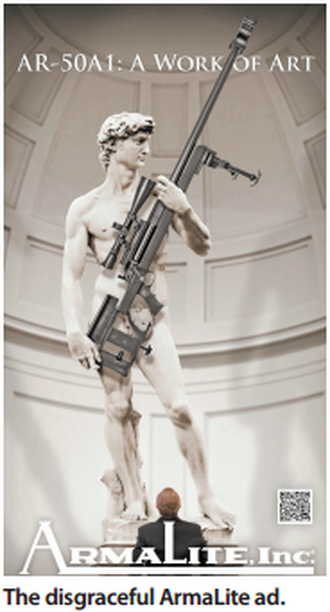Cristina Acidini, superintendent of Florence’s museums, was very upset with the ad and warned the company not to continue using the image. The issue is not only the bizarre image created but also that Florence museums do not allow use of their art works for commercial purposes without permission. The message got across quite quickly as Mark Johnson, the chief executive officer of ArmaLite’s parent company, Strategic Armory Corps, LLC, said, “I believe that an advertisement utilizing an altered photograph of a masterpiece such as David is in poor taste. We deeply regret that ArmaLite offended anyone by this media campaign, which we ended upon our acquisition of the company. We will make every effort to be sure that any remnants from the campaign are removed from the public.” In this case the response from ArmaLite’s parent company was swift and clear. The image that had been publicly defaced in print is one of the world’s greatest art treasures. Yet, one must ask just how could any advertising manager conjure up this idea to use such a universally acclaimed masterpiece without permission and for such a product and not expect negative response? The answer may very well lie in the history of image distortion of things Italian. Is it just coincidental that a weapon and its associated image is at the heart of this ad or is it just tastelessness? What was telling in the many blog postings associated with the news media’s coverage of this story, were first, the many posts arguing a First Amendment right of the gun manufacturer to publish the ad. The second were the many posts attacking the Italian government for its outrage and the associated anti- Italian tone of some of the posts. One post on Huff Post put it this way, “who really cares what Italians think? It’s not exactly like they are the powerhouse in the EU or have much else to say anywhere.” Another wrote, “I know Italy used to be fascist but come on guys it’s time to get re-acquainted with free speech.” What is clear is that respect for the sensibilities of others is often lacking in these blogs. Writers vent their political and personal feelings in rapid response mode without much thought and reflection to the consequences. This is much like the advertising manager who decided that using the image of Michelangelo’s David armed with a powerful weapon would be just fine. Or maybe the intent was to stir up controversy and coverage. In either case, the consequences were not well considered. The IAOVC applauds the actions of the Italian government in attacking this bizarre image. The constant fallback position of supporters of these types of shock images, that free speech trumps all else is patently false. Advertisers need to reexamine their ethos. The American Association of Advertising Agencies revised its Creative Code in 2011 which commits its members to five codes. Two of these codes are applicable in this matter. The Creative Code reads as follows, “Specifically, we will not knowingly create advertising that contains: (a) False or misleading statements or exaggerations, visual or verbal, and, (e) Statements, suggestions, or pictures offensive to public decency or minority segments of the population.” The Creative Code also contains provisions for disciplining members. The Code reads as follows, “Clear and willful violations of these Standards of Practice may be referred to the Board of Directors of the American Association of Advertising Agencies for appropriate action, including possible annulment of membership as provided by Article IV, Section 5, of the Constitution and By-Laws.” The IAOVC will soon test the application of this rule by the industry in policing its members. Stay tuned.
0 Comments
Leave a Reply. |
Archives
January 2015
Categories |
The Italian American ONE VOICE Coalition, Inc. is an IRS registered 501(c)3 non-profit corporation - EIN 22-3361110.
© Italian American ONE VOICE Coalition. All rights reserved.


 RSS Feed
RSS Feed